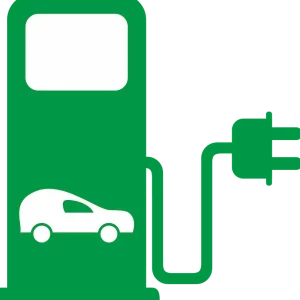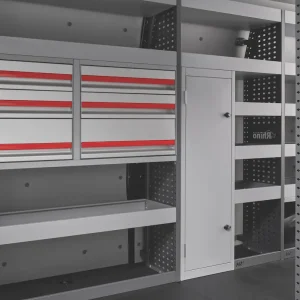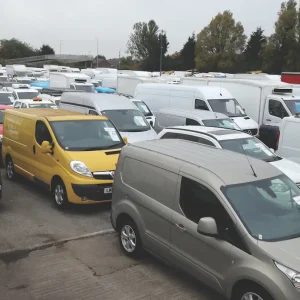With the noise around inner-city diesel emissions growing ever louder, operators are wondering more and more if going electric might be the answer.
While electric vans have slowly come onto the market in recent years, few have been the large vans wanted for last-mile deliveries in urban areas. Now though, following in the wheel tracks of the Renault Master Z.E., Volkswagen has unveiled its answer to the problem: the fully electric e-Crafter.
Engine and gearbox
Cutting-edge technology it may be, but the e-Crafter’s electric motor is in fact tried and tested – it’s the same powertrain that VW has previously deployed in the e-Golf passenger car. It powers the front wheels via a single-speed automatic transmission.
The van’s 35.8kWh battery can be charged to 80% capacity in 45 minutes using a 40kW direct current charging station, or alternatively can be fully recharged in five hours and 20 minutes using a 7.2kW AC wallbox – something VW expects to be done overnight at company depots.
Driving
VW says a survey of its customers found most vans cover between 70km and 100km (43-62 miles) per day, and that the e-Crafter has been designed to meet this need, and to address real-world operational requirements rather than maximise theoretical range. It quotes an New European Driving Cycle (NEDC) range of 107 miles, but says in pre-production trials fleets averaged 62 miles in everyday operations. In another reflection of how VW sees the e-Crafter as a strictly urban machine, the top speed is limited to 56mph.
Moving away, one of the often-cited features of electric vehicles – the immediacy of the power delivery – catches the attention straight away. Press the accelerator pedal and the response is instant – and impressive.
We tried the e-Crafter both empty and with a 400kg load in the back, and even with the latter it was pretty sprightly, while empty it fairly rockets away from traffic lights – something that takes a lot of stress out of jostling for position on busy city streets. Then, when you come to slow down again, the regenerative effect of the electric drivetrain helps with braking, which once you get used to it really helps with smooth driving.
The powertrain has other advantages too: having a single-speed transmission is sure to be a relief to a city-based driver used to going up and down cogs all day. They’ll likely also enjoy the lack of noise that accompanies it – it’s a real boon to accelerate in a van and only hear a faint electric whirring rather than a roaring diesel engine. It makes driving the e-Crafter a far more refined and relaxing experience – something helped also by a smooth ride.
That lack of sound does have a downside though, in particular in the urban environments the e-Crafter was designed for: people don’t hear you coming. On one occasion on our test drive in Hamburg a pedestrian strolled halfway across the road before turning and realising with a start that a 3.5t van was near-silently bearing down on them, while on another occasion a pair of cyclists on a narrow stretch of road were clearly surprised to see us closing in when they moved to the other side of the road to overtake a parked bus.
It’s something you do have to be aware of when driving, and VW says it intends to address the problem by fitting a noise-generating system at some point before the EU mandates it in 2020.
Better suited to the city as things stand is the e-Crafter’s light steering, which makes manouvering easy, and the standard ParkPilot system, which includes side protection sensors and front and rear cameras to help avoid any knocks.
Load bay
One reassuring aspect for wary operators is that choosing an e-Crafter over a regular model doesn’t mean sacrificing load space. VW says the latest Crafter was designed from the start with an electric version in mind, which means space has been provided in its underbody to store the battery. This means the e-Crafter’s cargo capacity (10.7m3), through-loading width (1,380mm) and cargo compartment height (1,380mm) are all unchanged from the diesel model.
Based on the second-generation Crafter that launched in 2017, it’s available at weights from 3..5t to 4.25t, and with claimed payloads from 970kg to 1,720kg.
Interior and equipment
The familiarity continues when you climb aboard – the interior is also taken from the regular Crafter. Materials used feel sturdy and well put together, while the seats offer a good level of support. Standard equipment of note here includes the Discover Media satnav system, which we thought could have been placed a bit closer to the driver to make it easier to read, although directions are also displayed on the instrument panel.
Other standard features include automatic post-collision braking, which helps to avoid further collisions following a crash, cross-wind assistance, LED lights and automatic air-conditioning.
There’s a lot to like about the e-Crafter then. However, there is a rather major snag. Although VW’s marketing says the e-Crafter is “the right vehicle at the right time” it’s going to be quite a long time before UK drivers can get their hands on it.
While it’s gone on sale in Europe – and several UK fleets drove it as part of VW’s pre-launch testing – it won’t be on sale here until at least 2020. UK specs and prices are also yet to be confirmed, although in Germany the e-Crafter cost around €69,500 – just over £62,000 at current rates.
Volkswagen e-Crafter MWB/high-roof
Price (ex-VAT, ex-PiVG) £62,200*
Price range (ex-VAT, ex-PiVG) £62,200*
Insurance group tbc
Warranty tbc
Service intervals tbc
Load length 3,265mm
Load width (min/max) 1,380/1,780mm
Load bay height 1,861mm
Gross payload 975kg
Load volume 10.7m3
Engine size/power 136hp electric motor
Range 107 miles (NEDC)
CO2 0g/km
* estimated





